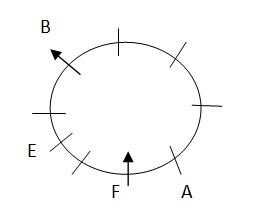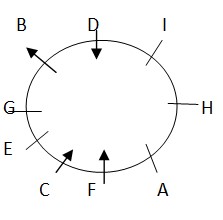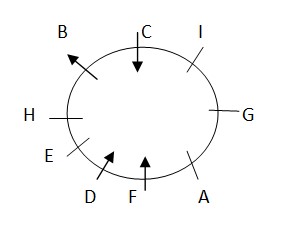Question
Who among the following doesn’t face same direction as
E? I. G II. F III. B Answer the questions based on the information given below. Nine persons A, B, C, D, E, F, G, H and I sit around a circular table such that only five of them face outside while others face towards the centre. E sits 2nd to the left of F. D and F face towards the centre. One person sits between E and B. A sits 4th to the right of B. H sits 2nd to the left of D. G sits 2nd to the left of C, who doesn’t face same direction as B. I doesn’t sit adjacent to H. Immediate neighbors of G face opposite direction to G. H doesn’t sit with F.Solution
E sits 2nd to the left of F, who faces towards the centre. One person sits between E and B. A sits 4th to the right of B. So, A sits immediate right of F. B faces outside.  H sits 2nd to the left of D, who faces towards the centre. G sits 2nd to the left of C, who doesn’t face same direction as B. H doesn’t sit with F. So, H sits 3rd to the right of B or immediate left of B and C sits immediate left of F or 4th to the right of F. Case I: C sits immediate left of F:
H sits 2nd to the left of D, who faces towards the centre. G sits 2nd to the left of C, who doesn’t face same direction as B. H doesn’t sit with F. So, H sits 3rd to the right of B or immediate left of B and C sits immediate left of F or 4th to the right of F. Case I: C sits immediate left of F:  Case II: C sits 4th to the right of F:
Case II: C sits 4th to the right of F:  I doesn’t sit adjacent to H, so case I is rejected. Immediate neighbors of G face opposite direction to G. So, G must face towards the centre while I and A face outside and H and E face outside. The final seating arrangement is given below:
I doesn’t sit adjacent to H, so case I is rejected. Immediate neighbors of G face opposite direction to G. So, G must face towards the centre while I and A face outside and H and E face outside. The final seating arrangement is given below: 
For one thing, they require (A)/you to think on your feet and (B)/call on all your resources to (C)/get passed them, reaffirming your commitment (D).
In each of the questions, a sentence is divided into five parts A, B, C, D and E in which two of the parts have some grammatical errors in them. You ha...
A sentence has been divided into four parts, one of which may contain an error. Identify that fragment and mark it as your answer. Mark (E) if the sent...
Even after all the corruption and mismanagement, the tribals of the North Eastern Region continue to send there children to study in government schools.
On our attempting to restore (a) / the picture to its original condition (b) / almost irreparable damage was discovered (c) / No error (d)
It being a stormy night, (a)/ you must thought of postponing (b)/ all your programmes till tomorrow morning. (c)/ No error (d)
One major reason (1) / for the popularity of television is (2) / that most people like to stay at home. (3) / No error (4).
The following sentence has been split into four segments. Identify the segment that contains a grammatical error.
After / a long and fun-fill...
A sentence has been divided into four parts, one of which may contain an error. Identify that fragment and mark it as your answer. Mark (E) if the sent...
I immediately quitted (1)/ the job in which (2)/ neither the skill nor (3)/ knowledge was required. (4)/ No error (5)
Relevant for Exams:


